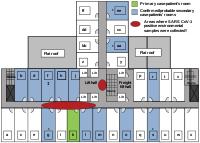
Photo from wikipedia
Malaria hotspots have been the focus of public health managers for several years due to the potential elimination gains that can be obtained from targeting them. The identification of hotspots… Click to show full abstract
Malaria hotspots have been the focus of public health managers for several years due to the potential elimination gains that can be obtained from targeting them. The identification of hotspots must be accompanied by the description of the overall network of stable and unstable hotspots of malaria, especially in medium and low transmission settings where malaria elimination is targeted. Targeting hotspots with malaria control interventions has, so far, not produced expected benefits. In this work we have employed a mechanistic-stochastic algorithm to identify clusters of super-spreader houses and their related stable hotspots by accounting for mosquito flight capabilities and the spatial configuration of malaria infections at the house level. Our results show that the number of super-spreading houses and hotspots is dependent on the spatial configuration of the villages. In addition, super-spreaders are also associated to house characteristics such as livestock and family composition. We found that most of the transmission is associated with winds between 6pm and 10pm although later hours are also important. Mixed mosquito flight (downwind and upwind both with random components) were the most likely movements causing the spread of malaria in two out of the three study areas. Finally, our algorithm (named MALSWOTS) provided an estimate of the speed of malaria infection progression from house to house which was around 200–400 meters per day, a figure coherent with mark-release-recapture studies of Anopheles dispersion. Cross validation using an out-of-sample procedure showed accurate identification of hotspots. Our findings provide a significant contribution towards the identification and development of optimal tools for efficient and effective spatio-temporal targeted malaria interventions over potential hotspot areas.
Journal Title: PLoS Pathogens
Year Published: 2022
Link to full text (if available)
Share on Social Media: Sign Up to like & get
recommendations!